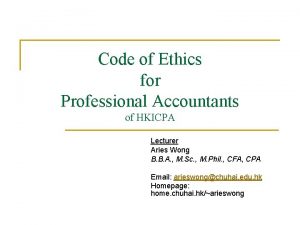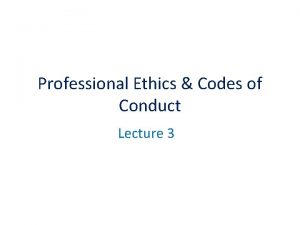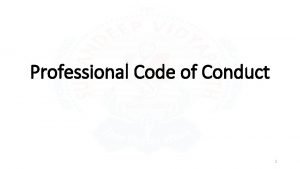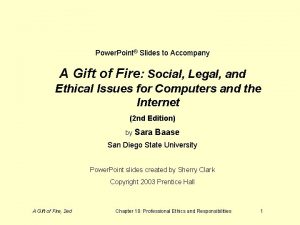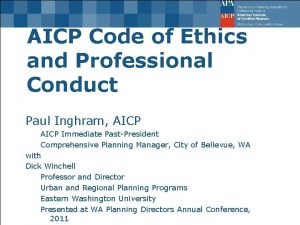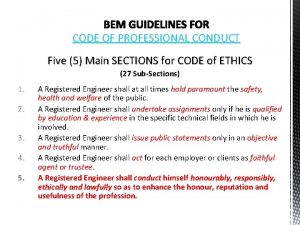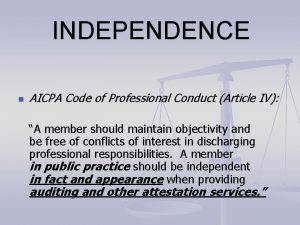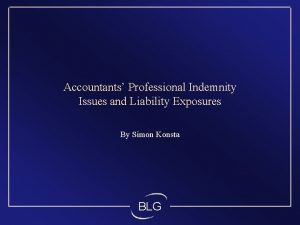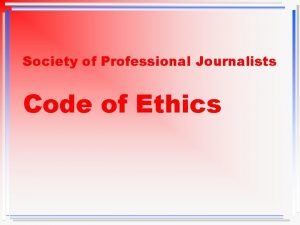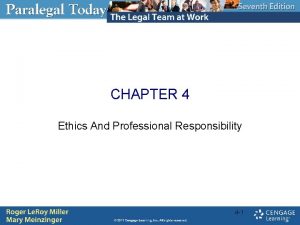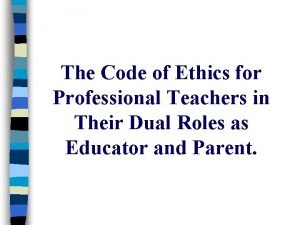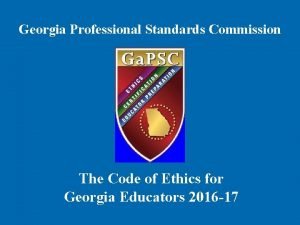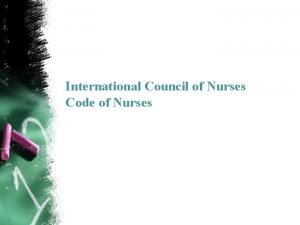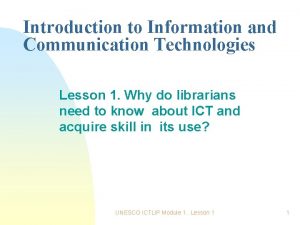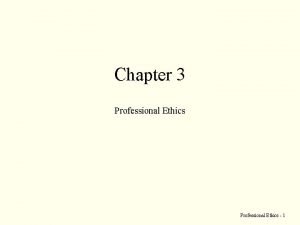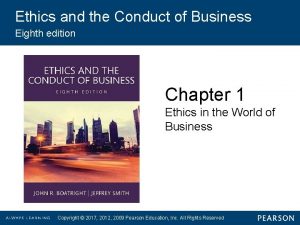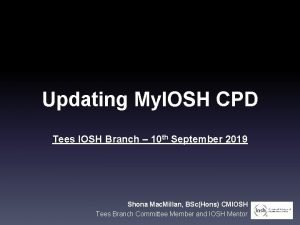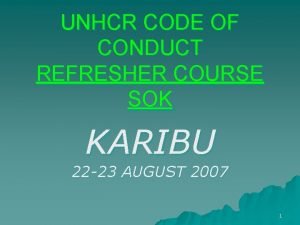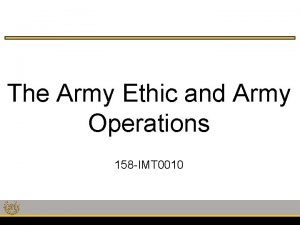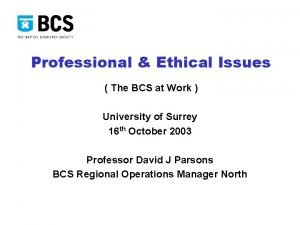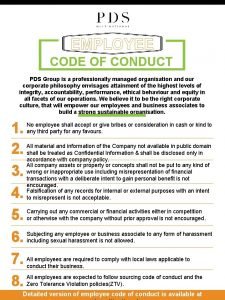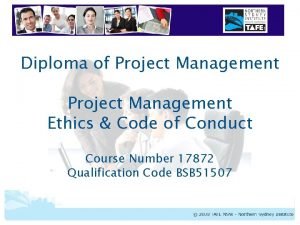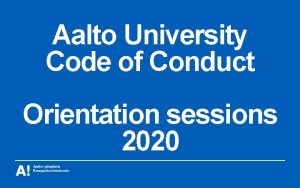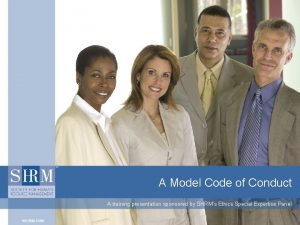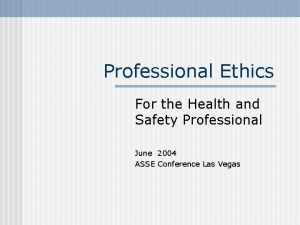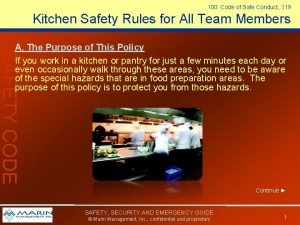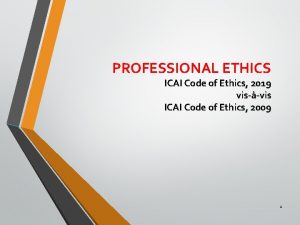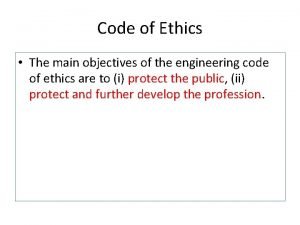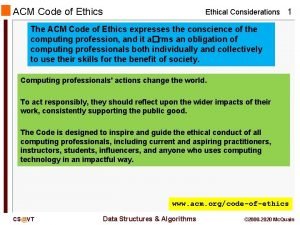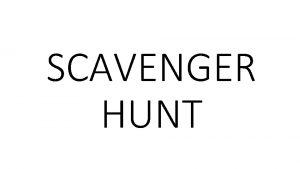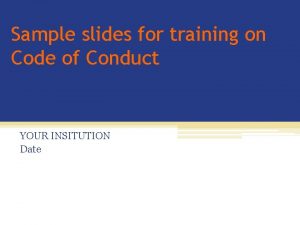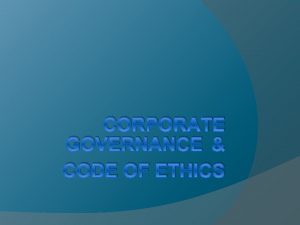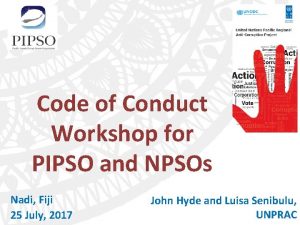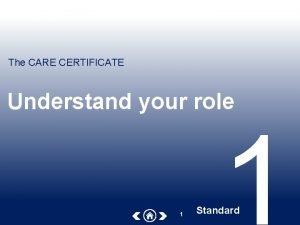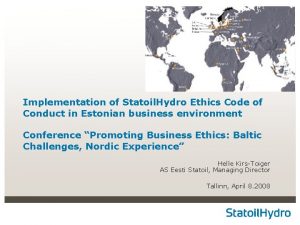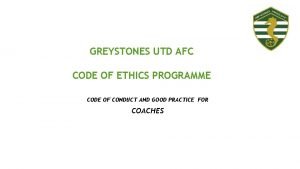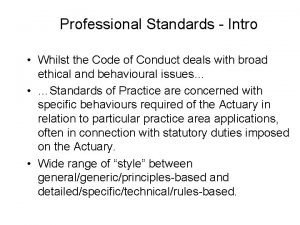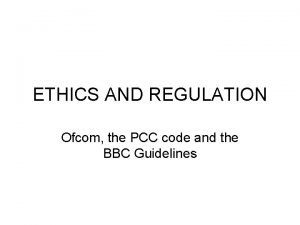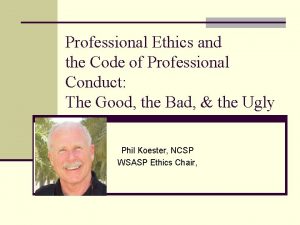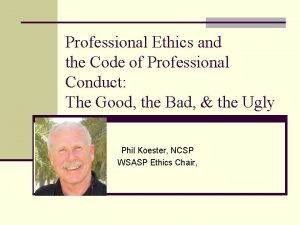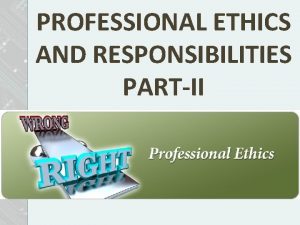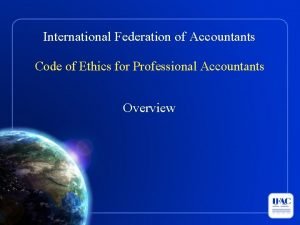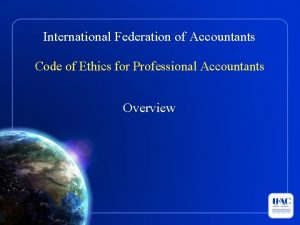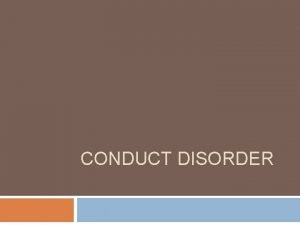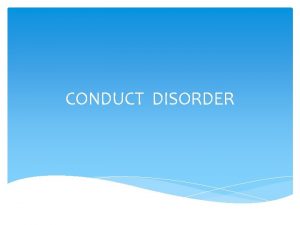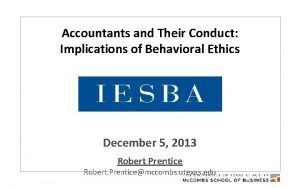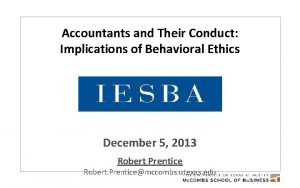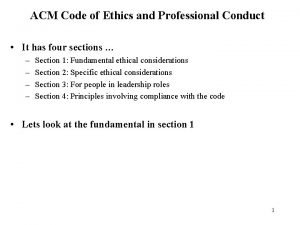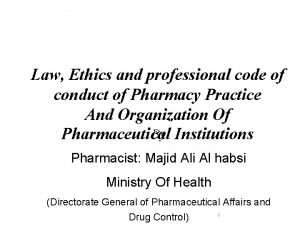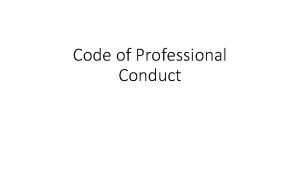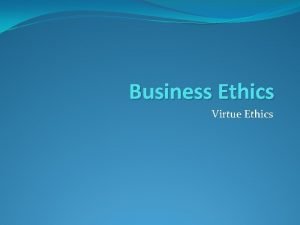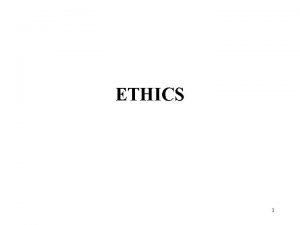CODE OF CONDUCT FOR PROFESSIONAL ACCOUNTANTS INTERNATIONAL ETHICS


















































- Slides: 50

CODE OF CONDUCT FOR PROFESSIONAL ACCOUNTANTS INTERNATIONAL ETHICS STANDARDS BOARD FOR ACCOUNTANTS ( IESBA )

TODAY’S AGENDA 1. INTRODUCTION 2. HIGHLIGHTS OF THE CODE OF ETHICS FOR PROFESSIONAL ACCOUNTANTS – IESBA 3. CONCLUSION

INTRODUCTION NOTE: Ø The distinguishing mark of the Accountancy profession is its acceptance of the profession’s responsibility to act in the public interest. Ø The Code of Conduct for Professional Accountants is contained in the Code of Ethics issued by the International Ethics Standards Board of IFAC. Tanzania has adopted it fully

INTRODUCTION ( CONT. ) Ø The Code of Ethics is binding to all members of the profession i. e. members in public practice ( partners and staff ) and those in business and public service

INTRODUCTION ( CONT. ) IESBA CODE OF ETHICS : Ø PART A : General Application of the IESBA Code to all Professional Accountants Ø PART B: Application of the IESBA Code to Professional Accountants in Public Practice Ø PART C: Application of the IESBA Code to Professional Accountants in Business

IESBA CODE OF ETHICS FOR ACCOUNTANTS

GENERAL APPLICATION OF THE IESBA CODE PART A OF THE CODE ESTABLISHES: Ø Fundamental Principles of Professional Ethics for Professional Accountants and provides Ø Conceptual Framework to be applied by Professional Accountants in order to identify, evaluate threats and apply safeguards to eliminate or reduce threats to an acceptable level

PART A FUNDAMENTAL PRINCIPLES: 1)Integrity: This requires the Professional Accountant to § to be straight forward and honest § not to be associated knowingly with reports, returns, communication etc. where the accountant believes are materially false or misleading; or recklessly furnished; or omits or obscures information

PART A FUNDAMENTAL PRINCIPLES: ( Cont. ) 2)Objectivity: This requires the Professional Accountant not to compromise professional judgment because of bias, conflict of interest or undue influence of other parties

PART A FUNDAMENTAL PRINCIPLES: ( Cont. ) 3) Professional Competence and Due Care This imposes the following obligations to the Professional Accountant to: Ø Maintain professional knowledge and skill at required levels Ø Act diligently according to applicable technical and professional standards Ø Ensure that those working under him/her have appropriate training and supervision Ø Tell the client his/her limitations

PART A FUNDAMENTAL PRINCIPLES: ( Cont. ) 4) Confidentiality This imposes an obligation to the Professional Accountant to refrain from: Ø Disclosing confidential information without specific authority Ø Using confidential information for personal advantage or advantage of third parties

PART A FUNDAMENTAL PRINCIPLES: ( Cont. ) 5) Professional Behavior This imposes an obligation to the Professional Accountant to comply with relevant laws and regulations and avoid any action which may discredit the profession. Therefore members shall behave with courtesy and consideration towards those with whom they come into contact in a professional capacity

PART A IESBA ESTABLISHES CONCEPTUAL FRAMEWORK APPROACH Because professional accountants operate in different circumstances and the nature of their engagements and work assignments may differ and therefore: Impossible to define every situation and every threat faced by the accountant

PART A CONCEPTUAL FRAMEWORK APPROACH This approach requires the Professional Accountant to : Ø Identify threats to compliance with Fundamental Principles Ø Evaluate the significance of the threats and Ø Apply safeguards to eliminate threats or reduce them to acceptable levels

PART A Categories of threats to Compliance with Fundamental Principles: a) Self interest threats b) Self review threats c) Advocacy threats d) Familiarity threats e) Intimidation threats

PART A The professional accountant must identify, evaluate and apply safeguards which may eliminate threats or reduce them to an acceptable level. Safeguards fall into two categories: Ø Safeguards created by the profession, legislation or regulation Ø Safeguards in the work environment

PART A CONFLICTS IN COMPLYING WITH FUNDAMENTAL PRINCIPLES: Conflicts may be with or within the organization where a professional activity takes place. A threat to objectivity or other fundamental principles may arise; e. g. Ø Activity done for conflicting parties Ø Conflict of interest between the accountant and the client

PART A ETHICAL CONFLICT RESOLUTION When considering to resolve a conflict in complying with the Fundamental Principles, the following factors may be relevant: a) Relevant facts b) Ethical issues involved c) Fundamental Principle in question d) Established internal procedures e) Alternative courses of action available

PART B: APPLICATION OF THE IESBA CODE TO PROFESSIONAL ACCOUNTANTS IN PUBLIC PRACTICE This part provides guidelines on how the Conceptual Framework Approach in Part A is applied to various situations faced by the Professional Accountant in Public Practice. Threats fall in one or more of the following categories: a) Self-interest b) Self-review c) Advocacy d) Familiarity and e) e) Intimidation

PART B Professional Appointment This section provides guidelines on threats and safeguards with regard to: Ø Client Acceptance Ø Engagement Acceptance Ø Changes in a Professional Appointment

PART B Conflicts of Interest This section sets out the obligation of the Professional Accountant to identify circumstances which may create threats of conflict of Interest, evaluate the significance of any threats and apply safeguards or additional safeguards.

PART B Conflicts of Interest faced by the Professional Accountant in Public Practice which create threats to objectivity and which may create threats to the other Fundamental Principles: Ø Providing services to clients whose interests on the particular matter are in conflict; e. g. Ø Providing services to a client whose interest and that of the accountant on the matter are in conflict. e. g.

PART B What the Professional Accountant in Public Practice should do: Ø When identifying and evaluating the interests and relationships, exercise professional judgment Ø When addressing conflicts of interest, remain alert to the Fundamental Principle of Confidentiality

PART B What to do: Ø If the threat created by a conflict of interest is not at acceptable level, apply safeguards to eliminate or reduce threat, if not decline or discontinue the professional relationship Ø Before accepting a new engagement take steps to identify circumstances which might create a conflict of interest. These include nature of relationship, the service and the parties

PART B What to do: ( cont. ) Ø Have an effective conflict identification process in order to identify actual or potential conflicts of interest before accepting or continuing an engagement. The process of identifying conflicts depends on nature of services to be provided, size of the firm, size and nature of client and structure of the firm

PART B What to do: ( cont. ) Ø If a conflict of interest has been identified, evaluate the significance of the interests or relationship and the significance of the threats created by performing the professional services

PART B What to do: ( cont. ) Ø When there are threats to compliance with Fundamental Principles created by conflict of interest, apply safeguards, such as: a) mechanism to prevent unauthorised disclosure of confidential information b)regular review of the safeguards c)get somebody independent to review the work performed d) consult third party

PART B What to do: ( cont. ) Ø Disclose the nature of the conflict of interest and related safeguards to the client affected by the conflict. Forms of disclosure include: a) General disclosure to clients b) Specific disclosure to affected clients Ø Obtain the client’s consent to the accountant performing the professional services

PART B Second Opinion: Where a Professional Accountant in Public Practice is asked for second opinion, he/she shall identify and evaluate the significance of any threats to compliance with Fundamental Principles and apply appropriate safeguards.

PART B Fees and Other Types of Remuneration: Fees may create threats to compliance with Fundamental Principles e. g. a self-interest threat to professional competence and due care if the fee quoted is too low.

PART B Marketing Professional Services: A Professional Accountant in Public Practice shall be honest and truthful when marketing his/her professional services. Do not make exaggerated claims in respect of services offered, qualifications and experience Do not make references to the work of others

PART B Gifts and Hospitality: Offers of gifts and hospitality from clients may create threats to compliance with Fundamental Principles e. g. threat to objectivity Evaluate the significance of the threat and apply safeguards. If threats cannot be eliminated or reduced, do not accept such an offer

PART B Custody of Client Assets: A Professional Accountant in Public Practice shall not assume custody of client monies or assets unless permitted by law. Threats created by this include self-interest threat to professional behavior and of objectivity. Safeguards include: Keeping client assets separate and use them only for the intended purpose. Comply with the law

PART B Objectivity - All Services: A Professional Accountant in Public Practice shall determine, at the outset, whethere are threats to compliance with the Fundamental Principle of Objectivity because of the relationships with directors, officers or employees. A Professional Accountant must be Independent in Mind and in Appearance

PART B INDEPENDENCE: Independence Requirements For Audit and Review Engagements have the objective of assisting firms and members of audit teams in applying the Conceptual Framework approach to achieving and maintaining Independence. I. E. Independence of Mind and Independence in Appearance

PART B INDEPENDENCE: Independence Requirements for Other Assurance Engagements which are not audit or review engagements. Compliance with the Fundamental Principle of Objectivity requires being Independent of assurance clients. It is in the public interest and therefore required by the Code of Ethics that firms and members of the assurance team be independent of the client.

PART C: APPLICATION OF THE IESBA CODE TO PROFESSIONAL ACCOUNTANTS IN BUSINESS This Part explains the Application of Conceptual Framework Approach to Professional Accountants in Business. Investors, employers and the public may rely on the work of a Professional Accountant. There are various forms of relationships with an employer, e. g. as a salaried employee or director Threats to compliance with Fundamental Principles may therefore exist

PART C 1. Conflicts of Interest: A professional accountant in business may be faced with a conflict of interest when undertaking a professional activity. Threats created by the conflict may occur when: a) The accountant undertakes professional activity for parties with conflicting interests b) The interest of the accountant and those of the other party are in conflict

PART C What to do: Ø Apply professional judgment when identifying and evaluating the interests and relationships Ø Seek guidance when addressing a conflict of interest. Guidance from within the employing organization or from others Ø Apply safeguards to eliminate threat or to reduce it to acceptable level

PART C What to do: ( cont. ) Ø Apply one or more of the following safeguards: a) Restructuring or segregating certain duties b)Obtaining appropriate oversight c)Withdraw from the decision-making process d)Consult with third parties e. g. NBAA, legal counsel or an other accountant

PART C 2. Preparation and Reporting of Information: Financial information shall be prepared and presented fairly, honestly and in accordance to professional standards. Threats to compliance with Fundamental Principles may exist e. g. self- interest or intimidation threats to integrity, objectivity or professional competence or due care The significance of the threats should be evaluated and necessary safeguards applied

PART C What to do: Ø Be alert to the principle of integrity, which imposes an obligation to be straightforward and honest in all business and professional relationships Ø Evaluate the significance of the threat and apply safeguards when necessary e. g. consult with superiors or the audit committee etc.

PART C What to do: ( cont. ) Ø Refuse to be or remain associated with misleading information Ø Take steps to disassociate yourself from the misleading information if you have been associated with it unknowingly Ø Obtain legal advice to determine whether to report the circumstances outside the organization

PART C 3. Acting with Sufficient Expertise: A professional Accountant shall not mislead an employer as to the level expertise or experience possessed. Be ready to seek appropriate expert advice or assistance Threats to compliance may be created by insufficient time, information, experience and even resources. Appropriate safeguards shall be applied.

PART C 4. Financial Interests, Compensation and Incentives Linked to Financial Reporting and Decision Making A Professional Accountant may have financial interests in the entity, e. g. shares, share options, profit related bonuses etc. Self-interest threats arising from compensation and incentives may be compounded by pressure from superiors or peers

PART C What to do: Ø Be particularly alert to the principle of integrity which imposes an obligation to be straightforward an honest in all professional and business relationships Ø Evaluate the significance of any threat created and safeguards applied. In doing so, evaluate the nature and significance of the interest. Examples of safeguards to be applied:

PART C 5. Inducements: 5(a)Receiving Offers of inducements may create threats to compliance with Fundamental Principles. Evaluate the significance of any threat and apply safeguards when necessary e. g. inform higher level of management, inform third party e. g. professional body

PART C 5. Inducements: 5(b) Making Offers A Professional Accountant may be in a situation where he/she is expected or under pressure to offer an inducement Do not offer an inducement to improperly influence professional judgment of a third party

In conclusion: Stay updated by attending CPD programs

THANK YOU AND BEST WISHES Simon C. Mponji
 Code of ethics for professional accountants
Code of ethics for professional accountants Acm code of ethics and professional conduct
Acm code of ethics and professional conduct Code of conduct professional ethics
Code of conduct professional ethics Cips code of ethics and professional conduct
Cips code of ethics and professional conduct Aicp code of ethics
Aicp code of ethics Code of conduct bem
Code of conduct bem Aicpa code of professional conduct summary
Aicpa code of professional conduct summary Aicpa code of professional conduct rule 101
Aicpa code of professional conduct rule 101 Accountants professional indemnity insurance
Accountants professional indemnity insurance Code of ethics society of professional journalists
Code of ethics society of professional journalists Article x the teacher and business
Article x the teacher and business Nala's paralegal canons of ethics
Nala's paralegal canons of ethics Spanish
Spanish Remunerative conduct examples
Remunerative conduct examples International council of nurses code of ethics
International council of nurses code of ethics Professional conduct of a teacher
Professional conduct of a teacher Ncees model rules of professional conduct
Ncees model rules of professional conduct Rules of professional conduct cpa ontario
Rules of professional conduct cpa ontario Ethics and the conduct of business
Ethics and the conduct of business Iosh ipd examples
Iosh ipd examples Code of conduct unhcr
Code of conduct unhcr Pow code of conduct
Pow code of conduct Army code of ethics
Army code of ethics British computer society code of conduct
British computer society code of conduct Code of conduct military
Code of conduct military Employee code of conduct
Employee code of conduct Project management code of conduct
Project management code of conduct Article of the code of conduct
Article of the code of conduct Aalto code of conduct
Aalto code of conduct Sample code of conduct training
Sample code of conduct training Loyaltynloyalty
Loyaltynloyalty Kitchen code of conduct
Kitchen code of conduct Code of conduct icai
Code of conduct icai Azethics
Azethics Engineering code of conduct
Engineering code of conduct Acm code of ethics
Acm code of ethics Transient contact
Transient contact Scavenger hunt
Scavenger hunt Code of conduct training examples
Code of conduct training examples Hp code of ethics
Hp code of ethics P&g code of conduct
P&g code of conduct Npsos
Npsos Code of conduct
Code of conduct Responsibilities to the individuals you support
Responsibilities to the individuals you support Code of conduct template
Code of conduct template Utd code of conduct
Utd code of conduct Ipra code of conduct
Ipra code of conduct Iaa code of conduct
Iaa code of conduct Pan european game information
Pan european game information Pcc code of conduct
Pcc code of conduct Busceral
Busceral
